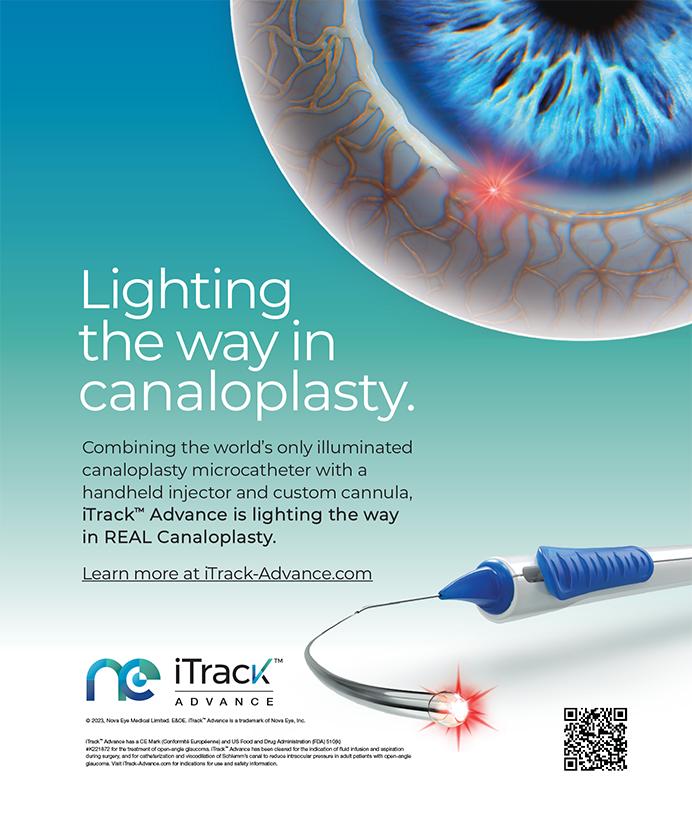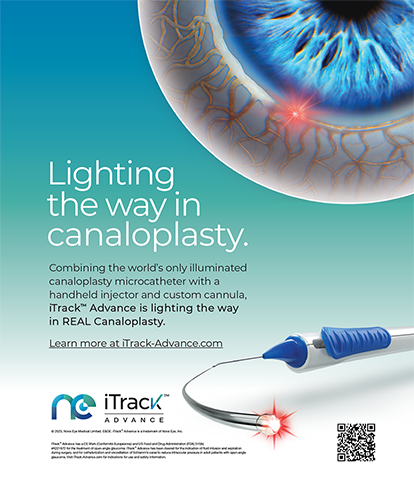Corneal collagen cross-linking (CXL; not approved in the United States), as introduced by Theo Seiler et al, has become the procedure of choice for arresting a progressing cone. CXL increases the number of cross-links between the corneal collagen fibrils, thereby increasing the rigidity and strength of the cornea. The application of ultraviolet A (UVA) light at 370 nm in the presence of a photosensitizer (topical riboflavin) leads to the production of oxygen free radicals. These free radicals induce collagen cross-links, which, in turn, create more compact inter- and intrahelical connections. CXL also flattens the cone to varying degrees, and it decreases these patients’ higher-order aberrations.
Riboflavin has an additional protective role in CXL: it helps to increase the absorption coefficient. With an irradiance of 3 mW/cm2 of UVA (at the corneal surface) and 0.1% riboflavin, 95% of UVA light is absorbed within the cornea, reducing final irradiance at the endothelial level to 0.18 mW/cm2 At a depth of 300 μm, irradiance is 0.37 mW/cm2, so 400 μm of riboflavin-saturated stroma above the endothelium is considered safe.
THE PROCEDURE
A significant number of patients have a minimum stromal thickness of less than 400 μm after epithelial removal, a contraindication to conventional CXL. For such patients, I am using a procedure that I call “contact lens-assisted CXL” or CACXL. It uses a riboflavin-soaked (UV-barrier-free) soft contact lens of negligible power to attenuate UV irradiance to safe amounts at the level of the endothelium.
CACXL artificially increases the thickness of the UV absorption medium anterior to the endothelium by means of the riboflavin-soaked contact lens and the minimal precorneal riboflavin film present under the contact lens. In so doing, the approach allows cross-linking to be performed on patients with thinner (> 350 μm in our experience so far vs > 400 μm) corneas after epithelial removal, thus broadening the pool of candidates.
TIPS AND TRICKS
In CACXL, the contact lens must not have a built-in UV barrier. It is a simple matter to check the product literature and the UV transmittance using a digital UV meter (Figure 1). The soft contact lens that I use is the UV-barrier-free Soflens daily disposable (Bausch + Lomb) made of hilafilcon B.
CACXL may be performed as an epithelium-on or epithelium-off technique, although the latter is my preference. The soft contact lens is soaked in the riboflavin solution for 30 minutes, the same as for the de-epithelialized cornea. The contact lens is then applied to the eye, and a precontact lens film is maintained over the contact lens (as in conventional CXL). The precorneal and precontact lens films are reapplied once every 3 minutes during treatment. UVA light with a wavelength of 370 nm is then applied for 30 minutes, after which the contact lens is removed, a balanced salt solution wash is performed, and a new contact lens is applied and remains in place until the epithelium has healed (Figure 2). Accelerated cross-linking is also possible using this technique.
ADVANTAGES
CACXL follows Lambert’s law. That is, each unit layer of a solution absorbs an equal fraction of light passing through it. The precontact lens riboflavin film maintains a riboflavin film above the attained 400 μm, which is in keeping with published works by Wollensak and colleagues, who consider the cornea and a precorneal riboflavin film together as a composite two-compartment system for CXL.1 In Wollensak’s system, the riboflavin film is an integral part of the cross-linking procedure, and it is important in achieving the correct stromal and endothelial UVA irradiance.
Another advantage of CACXL is that it is not dependent on the swelling properties of the cornea, as in hypo-osmolar cross-linking, and it produces a more stable riboflavin film. Anatomic and visual results have been encouraging in my early cases.
CONCLUSION
It is important to maintain a uniform thickness of the contact lens-riboflavin films during the treatment. If the contact lens buckles when placed on the eye, it may create an uneven precorneal riboflavin film and consequently lead to hot or cold spots. This problem is more common with a decentered lens or in an uncooperative patient who moves his or her eye excessively or who squeezes his or her eyelids against a compressible speculum. In such cases, the riboflavin films should be replenished as required and the lens recentered. Applying a consistent precontact lens layer also helps, as the posterior portion of this film fills the troughs on the surface of the contact lens and makes the thickness unvarying, whereas the anterior portion creates the composite two-compartment system, as required by Wollensak and colleagues (Figure 3).
Soosan Jacob, MS, FRCS, DNB, is a senior consultant ophthalmologist at Dr. Agarwal’s Eye Hospital and Eye Research Centre in Chennai, India. She acknowledged no financial interest in the products or companies mentioned herein. Dr. Jacob may be reached at dr_soosanj@hotmail.com.
- Wollensak G, Aurich H, Wirbelauer C, Sel S. Significance of the riboflavin film in corneal collagen crosslinking. J Cataract Refract Surg. 2010;36(1):114-120.


